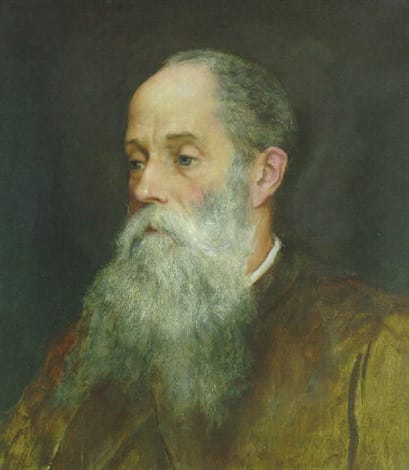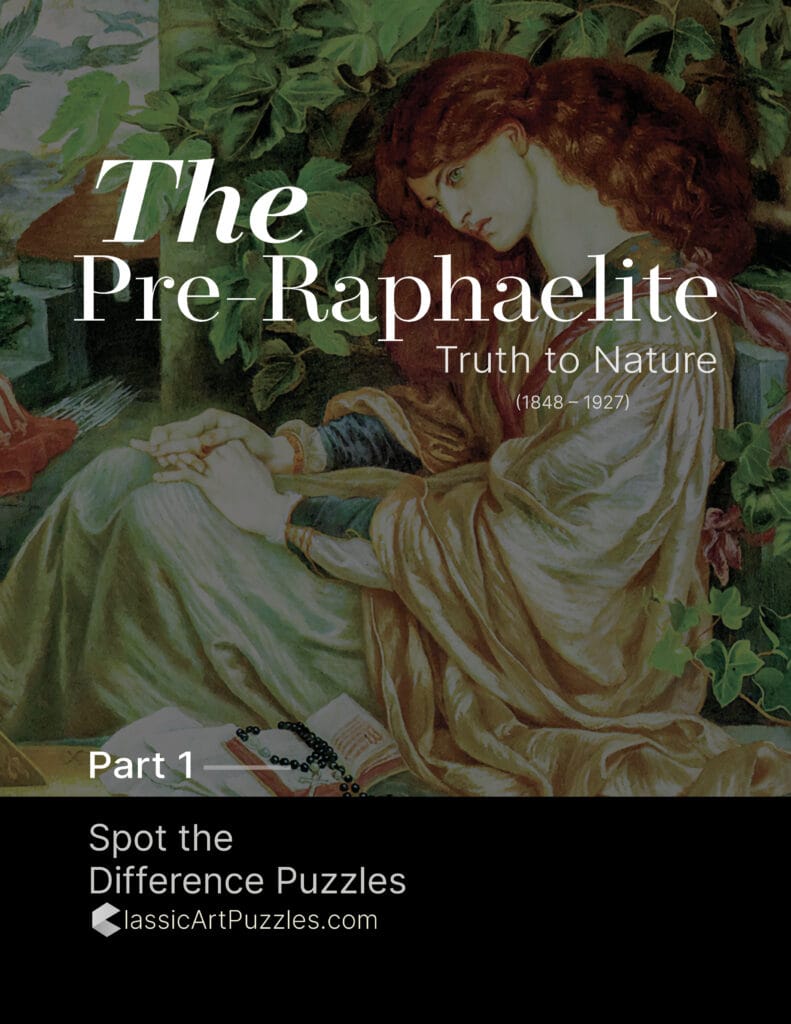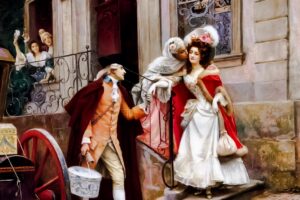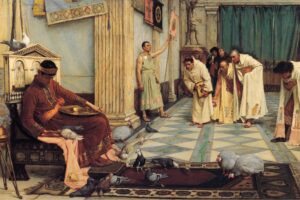Overview
Juliet and Her Nurse (c.1860) by John Roddam Spencer Stanhope reimagines a Shakespearean scene with quiet intensity. Juliet, clad in flowing russet and white, gazes longingly out of a mullioned window, while her nurse, seated nearby in black with a green fan, looks upward in reflective calm. Between them lies the tension of youth and age, passion and caution, longing and worldly wisdom.
Stanhope (1829–1908), a second-generation Pre-Raphaelite painter, infused literary subjects with Renaissance-inspired clarity. Here, he unites Shakespeare’s timeless drama with the Brotherhood’s devotion to vivid color, symbolic detail, and storytelling through setting.
When painted in the early 1860s, the work reflected Victorian admiration for Shakespeare as both poet and moral teacher. Today, it endures as a testament to how the Pre-Raphaelites transformed literary moments into living tableaux, filled with emotion and symbolic resonance.
About the Artist
John Roddam Spencer Stanhope (1829–1908) was an English painter aligned with the Pre-Raphaelite circle. A cousin of Rossetti and friend of Burne-Jones, he lived much of his life in Florence, where Italian Renaissance art profoundly shaped his style. His works often feature biblical, mythological, and literary themes, rendered with luminous color and rhythmic composition. Though quieter in fame than Millais or Rossetti, Stanhope remains a vital voice of the second Pre-Raphaelite generation.
The Story Behind the Painting
Shakespearean Inspiration
The subject is drawn from Shakespeare’s Romeo and Juliet. Juliet, on the cusp of her fateful romance with Romeo, shares intimate confidences with her Nurse. Stanhope’s interpretation presents not the balcony scene but a moment of stillness: Juliet’s gaze outward suggests yearning, while the Nurse’s presence anchors her in worldly care.
Victorian Shakespeare
For the Victorians, Shakespeare was both cultural icon and moral compass. Pre-Raphaelite painters often turned to his plays to explore themes of love, tragedy, and human conflict. In Stanhope’s work, Juliet becomes the embodiment of youthful longing, while the Nurse represents both loyalty and restraint.
Symbolism of Setting
The richly decorated interior — patterned carpet, ropes, and devotional images — conveys domesticity and spiritual undertones. The lattice window frames a world beyond, symbolizing Juliet’s restless desire to escape into love’s adventure.
Composition and Subjects
Juliet at the Window
Juliet stands at the window, her russet robe cascading in folds of Pre-Raphaelite richness. Her posture leans outward, as though straining toward freedom and passion beyond the domestic walls.
The Nurse’s Reflection
Seated in black, the Nurse holds a bright green fan, her gaze turned upward in pensive calm. She embodies age, caution, and experience, counterpoint to Juliet’s impulsive yearning.
The Interior Space
The chamber is steeped in detail: patterned rugs, ropes coiled on the floor, religious paintings hung on red walls. These objects are not incidental but symbolic — the ropes suggest entanglement, the devotional art moral oversight, and the carpet a tapestry of order restraining Juliet’s passion.
Color and Gesture
Stanhope arranges contrasts of color — Juliet’s warm russet against the Nurse’s somber black, the vivid green fan amid the darker tones. Gesture and hue together weave a dialogue between desire and restraint.
Art Style and Techniques
Pre-Raphaelite Naturalism
Stanhope employs the Brotherhood’s hallmark precision: every fold of fabric, pane of glass, and knot of rope is carefully rendered. The domestic interior becomes as alive as the figures themselves.
Renaissance Influence
Florentine Renaissance echoes permeate the scene, from the decorative rhythms to the balance of figures in architectural space. The figures’ solemn dignity recalls early Italian frescoes.
Symbolism in Detail
Objects carry moral meaning: ropes may allude to Juliet’s planned escape with Romeo, while the fan suggests concealment, and the window offers both hope and peril. Stanhope embeds Shakespeare’s tragedy within symbolic domestic imagery.
Legacy and Reflection
Reception
Paintings on Shakespearean themes were popular in mid-19th-century Britain, aligning with national pride in Shakespeare as “England’s Bard.” Stanhope’s version stood out for its quiet intensity rather than theatrical drama.
Enduring Significance
Today, Juliet and Her Nurse reveals how Pre-Raphaelite artists reinterpreted literature through symbolic domestic scenes. It speaks not only of Shakespeare’s tragedy but of the eternal dialogue between passion and wisdom, youth and age, longing and restraint.
Featured in Our Collection
Juliet and Her Nurse is featured in our Pre-Raphaelite Spot-the-Difference Puzzle Flipbook. Its richly patterned interior, symbolic objects, and contrasting figures make it a captivating puzzle subject. By engaging with the details, players experience Shakespearean drama through visual discovery, deepening appreciation for Stanhope’s artistry and the Pre-Raphaelite vision.
The Window of Longing
Juliet gazes outward, the Nurse sits within, and between them lies a silent exchange of love’s yearning and worldly caution. In Juliet and Her Nurse, Stanhope captures a Shakespearean moment not of speech but of stillness — where longing, wisdom, and symbolism intertwine.





